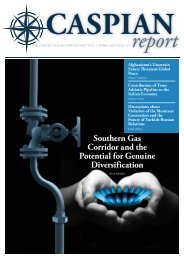Create successful ePaper yourself
Turn your PDF publications into a flip-book with our unique Google optimized e-Paper software.
MATTEO VERDA<br />
42<br />
of the global LNG market. Currently,<br />
India has significant regasification<br />
capacity: 4 terminals with a combined<br />
capacity of 38 bcm per year,<br />
of which 12 were commissioned in<br />
2013. Moreover, another terminal<br />
of 7 bcm per year is under construction<br />
and several others are at various<br />
stages of planning.<br />
Currently, all Indian imports are via<br />
LNG and the construction of a pipeline<br />
from Iran or Turkmenistan faces<br />
major geopolitical obstacles, and is<br />
unlikely to materialise anytime soon.<br />
As a consequence, LNG will supply<br />
the additional import demand of<br />
the Indian market. According to the<br />
IEA’s predictions, India will increase<br />
its imports from 17 bcm in 2013 to<br />
25 bcm in 2020 and 54 bcm in 2030.<br />
The sheer size of India’s estimated<br />
demand will affect global markets,<br />
creating more competition. However,<br />
unlike China, India has no alternative<br />
import sources to LNG and<br />
therefore the position of the producers<br />
will be strengthened.<br />
OUTLOOK TO 2020 AND BEYOND<br />
LNG is an Eastern Asian business<br />
and the situation is unlikely to<br />
change significantly within the current<br />
decade. Asian economies are<br />
growing, driving up energy demand.<br />
China and India will lead this trend,<br />
but smaller developing countries in<br />
the region will also see their energy<br />
imports grow steadily. Moreover, industrialised<br />
economies, namely Japan<br />
and South Korea, will continue<br />
to rely on massive energy imports,<br />
including LNG.<br />
Outside the region, a significant increase<br />
in LNG imports is likely only<br />
in Latin America, despite some uncertainty<br />
in the fundamentals of<br />
economic growth. Northern America<br />
is set to become an exporter of<br />
LNG, completely reversing expectations<br />
of just a few years ago.<br />
The European case is more complex,<br />
but the outlook for LNG demand is<br />
likely to remain very weak during<br />
this decade, and at best uncertain<br />
for the next one. European economic<br />
growth is weak and even in the case<br />
of a significant recovery, natural<br />
gas consumption will take a decade<br />
to return to pre-crisis levels, since<br />
improved efficiency and subsidised<br />
renewables have structurally reduced<br />
final demand for fossil fuels.<br />
Moreover LNG faces strong competition<br />
from exporters of piped gas,<br />
which are captive to costumers and<br />
ready to accept lower prices. Even<br />
in the most dynamic market, Turkey,<br />
LNG is likely to remain a secondary<br />
source of gas, due to the competition<br />
of piped gas from different sources.<br />
The only major driver for a surge in<br />
the European demand of LNG may be<br />
a further destabilisation of Ukraine<br />
or Northern Africa, with long interruptions<br />
to pipeline imports from<br />
Russia and Algeria. The impact on<br />
the LNG market will depend on the<br />
severity of those interruptions, but<br />
the likelihood of this scenario is very<br />
low. Moreover, interconnections between<br />
different European networks<br />
have significant bottlenecks, limiting<br />
the scope for a potential substitution<br />
of piped gas with LNG imports<br />
without massive investments.<br />
Considering LNG prices, current differentials<br />
between Eastern Asia and<br />
the rest of the world are based on the<br />
lack of alternatives for the main importers,<br />
Japan and South Korea. Increased<br />
supplies and a certain arbitration<br />
capacity for the Chinese buyers<br />
may lead to a structural lowering<br />
of the price level on the East Asian<br />
markets. However, the strength of<br />
the final demand in the region is<br />
likely to justify a positive differential<br />
between Asian and non-Asian prices<br />
even in the future decade.










